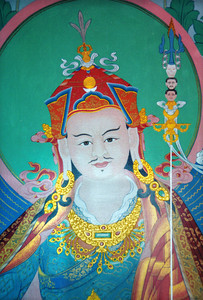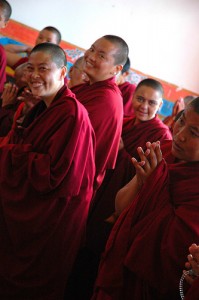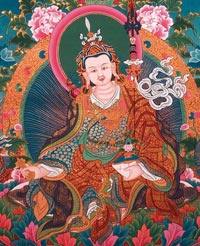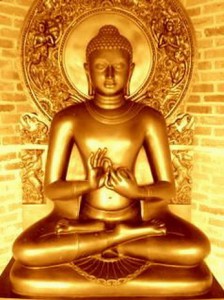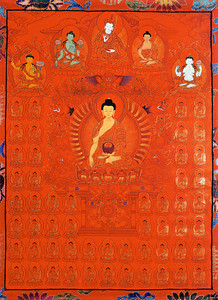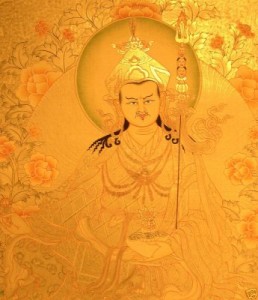
The most important part of the practice of Guru Yoga is when we receive the threefold empowerment from the guru. We receive the white light from the Guru’s head to our head to purify our body. We receive the red light from the Guru’s throat to our throat to purify and empower our speech. We receive the blue light from the Guru’s heart to our heart to purify and empower our mind. We should be receiving these empowerments 24 hours a day. Every time our mind has a little space, we should train ourselves to remember to receive the nectar of the Guru’s blessing. Instead, we walk around saying, “I’m lonely. I need my space. I need to go out and do stuff. I need to spend some money.” And we whine and carry on in samsara. And yet every minute this amazing phenomenal connection is available.
We should develop the habit of constantly keeping that connection. Whenever we have a moment, we should recite the Seven Line Prayer and ask for the guru’s blessing. And then we have it –boom, boom, boom—because when we ask, it is always given. There is never a time that when we ask, that it is not given. It may happen that we can’t receive the blessing sometimes. But we just keep trying. It’s simply our habit, and habits can change.
This is prayer without ceasing. This is constant prayer. This is a personal version of what we’re trying to do here at KPC by having our 24-hour prayer vigil, with someone practicing all the time. It is developing a constant awareness of our non-duality with the guru.
As we practice, the experience deepens. When we do our sit-down practice, the empowerments become easier to receive. We will find that we can go deeper and deeper and deeper. Then when we receive that three-part empowerment, our mind will be mixed with the guru and all the blessings will be present. But be careful: Pride will stop the blessing.
So we wire up. We take refuge and are anchored in our confidence. We know, “This is my guru; I am unshaken. This is the method; I am unbroken. This is the result that I am going toward.” We maintain that connection constantly. Any time we have a moment, we recall our root guru appearing as Guru Rinpoche and receive the empowerments, mixing our mind with the guru’s mind. That’s the way to awaken to non-duality. That’s the way to awaken to our nature. When we mix our mind with the guru’s, we are deeply empowered with the bodhicitta. We can hear the calls of the suffering ones. They will fill our ears.
When we take this empowerment and we mix our mind with the nectar of the Three Precious Jewels, then we can pray. We can see ourselves as the same as the guru in nature, not in a prideful sense. Having received the blessing of the guru and of all the masters of the lineage, we are now able to pray. We can ease the suffering of sentient beings. Why? Because we have the merit of our lineage. Now we can take within us the suffering of sentient beings because we can handle it. We have the power of the vajra masters. That is our joy, our bliss, our ecstasy. We are never separate from them.
So prayer comes when we are in a state of awakening–when the bodhicitta that is the nectar of the guru’s mind is mixed inseparably with our own mind. Then we can pray: we can speak with the authority of the bodhicitta, in the way of the bodhicitta.
Do you hear the sense of potency I am trying to describe? It is a sense of being fully mixed with the nectar of bodhicitta, fully aware that our nature is the bodhicitta. It is the bodhicitta that benefits sentient beings. When we are aware that we are the bodhicitta, it is this that we send to others. That is the power of the bodhisattvas and the Buddhas.
When we are that bodhicitta, we can awaken the bodhicitta in others just by looking at them. I know from experience that when His Holiness Penor Rinpoche looked at my heart, my heart was his and it opened. He recognized the bodhicitta in me, and I practiced to mix my mind with his. And therefore it was done. And that’s the potency of prayer. Now I can pray.
There is no room for pride in prayer—just simple gratitude for receiving the blessing of the guru in a humble way, with confidence in that blessing. Because of that blessing, we can pray. Now we have the bodhicitta; now we are the bodhicitta. And that is the potency and power upon which we rely.
The Buddhadharma is with us every minute. It’s a path, a way of life. And it is the true method to achieve the precious awakening. When we know that other beings are suffering so terribly, and we have found this jewel and it is in our hands and this nectar is given freely, I ask you: Why not learn to pray?
© Jetsunma Ahkon Lhamo
